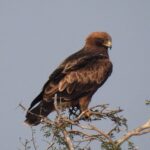Booted eagles have a varied diet that includes mammals, birds, reptiles, and insects. During the winter months, their diet primarily consists of mammals and birds, with rabbits being the most important mammalian prey.
Mammals: The Staple of Booted Eagles’ Winter Diet
In central Spain, a study found that mammals made up 41.6% of the prey items identified, with rabbits being the most common. Booted eagles are adept at hunting small to medium-sized mammals, such as:
- Rabbits
- Hares
- Rodents (e.g., voles, mice)
- Squirrels
These mammals provide a reliable and abundant source of food for booted eagles during the winter when other prey may be scarce.
Birds: A Significant Part of the Winter Menu
 Image source: Booted eagle By Dr. Raju Kasambe
Image source: Booted eagle By Dr. Raju Kasambe
Birds, particularly those that forage on the ground, also form a significant part of the booted eagle’s diet in winter. These avian prey include:
- Partridges
- Quails
- Larks
- Pipits
- Thrushes
In southern Africa, where 20% of the booted eagle population is the dark color morph, birds are the most common prey. However, the role of frogs in the diet of booted eagles in southern Africa is not well understood, with some studies suggesting they comprise an important part, while others have not observed this.
Reptiles and Insects: Occasional Additions to the Winter Feast
While mammals and birds make up the bulk of the booted eagle’s winter diet, they may also occasionally consume:
- Reptiles (e.g., snakes, lizards)
- Insects (e.g., beetles, grasshoppers)
These prey items are likely more common during the warmer months, but booted eagles may still incorporate them into their diet when available during the winter.
Adaptations for Winter Hunting
Booted eagles have several adaptations that allow them to successfully hunt and capture prey during the winter months:
- Powerful Talons: Their strong, sharp talons are well-suited for grasping and killing small to medium-sized mammals and birds.
- Keen Eyesight: Booted eagles have excellent eyesight, which helps them spot prey from a distance and track their movements.
- Agility in Flight: These eagles are agile flyers, able to maneuver quickly to catch their prey in the air or on the ground.
- Tolerance to Cold: Booted eagles are well-adapted to withstand the colder temperatures of winter, with their thick feathers and efficient thermoregulation.
Variations in Winter Diet Across Regions
The proportion of different prey types in the booted eagle’s winter diet can vary between populations, depending on the local availability of resources.
In central Spain, rabbits are the most important mammalian prey, while in southern Africa, birds are the most common prey. This highlights the adaptability of booted eagles to their local environments and the need to consider regional differences when studying their winter feeding habits.
Conclusion
Booted eagles are versatile predators that rely on a diverse range of prey to sustain themselves during the winter months. While mammals, particularly rabbits, are a staple in their diet, birds also play a significant role. Adaptations such as powerful talons, keen eyesight, and agility in flight allow booted eagles to successfully hunt and capture their winter prey, even in the face of colder temperatures and potentially scarce resources.
Understanding the winter feeding habits of booted eagles is crucial for their conservation and management, as it provides insights into their ecological role and the factors that influence their survival during the harsher months of the year.

